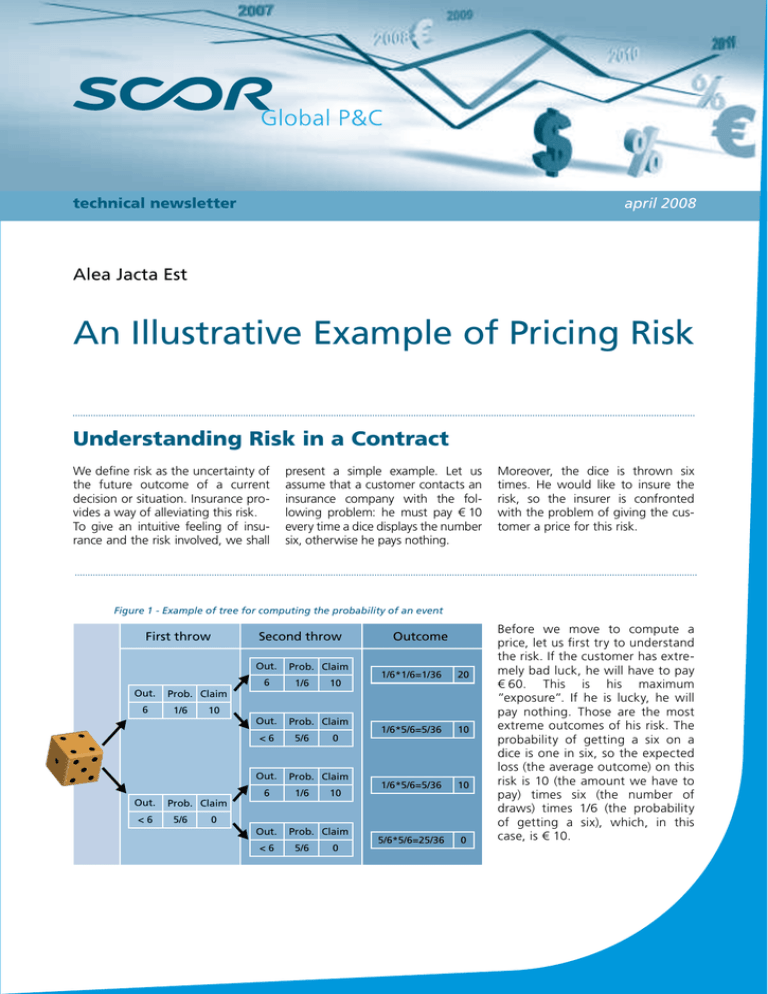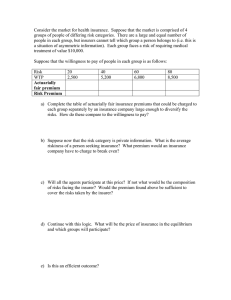
technical newsletter
april 2008
Alea Jacta Est
An Illustrative Example of Pricing Risk
Understanding Risk in a Contract
We define risk as the uncertainty of
the future outcome of a current
decision or situation. Insurance provides a way of alleviating this risk.
To give an intuitive feeling of insurance and the risk involved, we shall
present a simple example. Let us
assume that a customer contacts an
insurance company with the following problem: he must pay € 10
every time a dice displays the number
six, otherwise he pays nothing.
Moreover, the dice is thrown six
times. He would like to insure the
risk, so the insurer is confronted
with the problem of giving the customer a price for this risk.
Figure 1 - Example of tree for computing the probability of an event
First throw
Second throw
Out.
6
Out.
6
1/6
1/6
1/6*1/6=1/36
20
1/6*5/6=5/36
10
1/6*5/6=5/36
10
5/6*5/6=25/36
0
10
10
<6
Out.
6
<6
Prob. Claim
Prob. Claim
Out.
Out.
Outcome
Prob. Claim
5/6
0
Prob. Claim
1/6
10
Prob. Claim
5/6
0
Out.
<6
Prob. Claim
5/6
Before we move to compute a
price, let us first try to understand
the risk. If the customer has extremely bad luck, he will have to pay
€ 60. This is his maximum
”exposure”. If he is lucky, he will
pay nothing. Those are the most
extreme outcomes of his risk. The
probability of getting a six on a
dice is one in six, so the expected
loss (the average outcome) on this
risk is 10 (the amount we have to
pay) times six (the number of
draws) times 1/6 (the probability
of getting a six), which, in this
case, is € 10.
0
5
So the risk is that the customer will
have to pay more than expected,
which, at maximum, is 50 more. In
the worst case, there is a probability
of a little more than one in 50,000,
which is rather small, but is still a large
amount to pay. The probability that
the outcome is n times the six is (1/6)n.
Hence, we have the probability distribution of all the outcomes. In jargon
this is called ”loss distribution”. It is
the basis for building a pricing model.
At this point, we see the role of capital for an insurance company: it
ensures that the company can pay
its liability even in the worst case. In
a real insurance situation, the capital
will only cover the risk up to a certain, very low probability: 1% or
0.4%. The management of the company usually determines the level of
risk it is willing to accept. In our
example, a level of 0.4% means that
the insurance company would have
to put up capital for covering up to
three losses that would be € 20
on top of the expected € 10. That is
the risk-based capital (RBC) in this
simple example.
Role and Cost of Capital
Now let us think about the insurer:
if he prices the risk at € 60 plus
costs, he has no risk, but the customer will probably not buy the
contract because in reality he obtains
nothing (and actually loses because
of the costs). If the insurer prices the
risk at the expected loss (€ 10) plus
costs, he still runs the risk of losing
more in one out of three cases
(deduced from integrating the probability distribution). To make sure
that he can pay his liability in any
case, he needs a remaining capital
of € 50.
Figure 2 - Example of premium components and their origin
Premium
Company Structure
and Capital
Expenses
Cost of capital
Value-at-Risk
0.5
Risk Loading
0.15*(30-10)
3.0
Expected Loss
10.0
Loss Model
Mean
For insuring a sustainable business,
the insurer needs to pay back its
shareholders for the capital they
provided and make sure that its
expenses are covered. Let us assume
that the insurer’s costs are 0.5 and
its cost of capital before taxes1 is
15% (0.15*20=3). The insurer therefore needs to add a ”risk loading” to
its premium to pay for the cost of
the risk capital he has to put up for
this transaction. As already mentioned, this risk loading should be
neither too big – otherwise the customer will not buy the insurance –
nor too small – otherwise the insurer
cannot pay back its shareholders
and runs the risk of being short on
capital.
13.5
1
A capital cost of 15% before taxes is reasonable
because the investor will demand a risk premium for
this business making the price higher than the risk-free
rate, and taxes will take up to one third of the profits.
Insurance Premium as the ”Price of Risk”
The premium we have computed
here co mpris e s the e x p e c te d
loss + costs + the risk loading. The
insurer will ask for a premium of
10 + 0.5 + 3 = € 13.5. If the customer buys the insurance policy, he
will obtain ”capital relief” since he
does not have to put any money
aside for covering the risk. At its
highest, his capital relief would be
50, but he would generally compute
his risk-based capital the same way
as the insurer; we could assume that
he receives capital relief of 20.
Because of capital costs, the customer might be willing to buy the
contract in order to obtain this relief.
The insurer has received € 10 (plus
0.5 for covering the costs), put up
capital of 20 to cover his liability,
and got three to pay back to his
shareholders. If the outcome of the
contract is as expected, setting aside
the investment income to be made
on the received premium, he would
make a profit of 3 or a 15% return
on capital (since 20 had to be put up
as capital and 3 were earned in the
transaction). This is risk-based pricing of an insurance contract.
The more transactions of this kind
the insurer makes, the fewer chances
there are that he will have to pay the
full amount of the exposure (n times
60), and the more certain he will be
to pay the expected loss because of
the law of large numbers.
Increasing Risk Implies Higher Premium for the Same Expected Loss
To illustrate the influence of risk on
price, let us now assume that the
client is exposed to a slightly different
example than before. Now he is
exposed to only one throw of the
dice, but if a six is displayed, he has
to pay € 60. In this case the expected
outcome is still 10 (60 times 1/6) but
the risk is to pay 50 more (60 minus
the expected loss). Thus the insurer
would have to put up capital of
50 (at the same 1% threshold)
and would therefore ask a price of
10 + 0.5 + 7.5 = € 18. This example
shows that even if you have a risk
that has the same expected payment, its price can be much higher if
the exposure is higher. This second
example illustrates the fact that
increasing the limit on a deal, even if
the expected claim stays the same,
has a cost, which in this case is
18 – 13.5 = € 4.5, representing a
price increase of one third. This is
due to the increased risk of the
whole deal and thus a higher RBC.
Diversification Benefit and Reinsurer Role
With these simple examples, we see
the role of capital for an insurance
company and the mechanism of pricing risk. In practice, of course, risk
cannot be modelled as easily as with
the roll of a dice. One needs to use
an actuarial model to determine risk.
Yet our example is not that far from
reality. If we used the example of a
credit & surety insurance company
that holds a portfolio of six bonds,
each with a default probability of
1/6, we would come very close to it.
We also see here that diversification
is much more beneficial than increasing exposure on one bond.
A reinsurance company, on the
other hand, has a very diversified
portfolio that allows it to reduce the
risk of a single transaction. If we run
the example above in our own pricing tool, we would come up with a
price of € 11.5 for the first example,
with costs that are about the same
(0.5). For the second example, we
would come up with a price of
€ 12.5. In the latter, the risk loading
has doubled. The difference in price
is due to the fact that the value of
this risk does not only depend on
the risk itself, but also on the
portfolio of the company (i.e. the
other risks in the book), which is
very diversified. Thus the relative
price of the risk (relative to our
portfolio) is much lower, because
the additional risk is diversified away
in our portfolio. This is the main
advantage of reinsurance.
Michel Dacorogna
Direct phone +41 44 639 97 60 - Direct fax +41 44 639 99 61 - mdacorogna@scor.com
1, avenue du Général de Gaulle - 92074 Paris La Défense Cedex France
Editor: Dominique Dionnet (Mrs) - Stategy & Development - Operational Marketing
Phone: + 33 (0)1 46 98 74 00 - Fax: + 33 (0)1 46 98 84 49 - ddionnet@scor.com
All rights reserved. No part of this publication cannot be reproduced in any form without SCOR Global P&C’s autorisation.
4
Design and conception: Franklin Partners - (04/2008).
SCOR Global P&C




